-
 bitcoin
bitcoin $101752.865364 USD
-1.09% -
 ethereum
ethereum $3382.985899 USD
-1.38% -
 tether
tether $0.999658 USD
0.04% -
 xrp
xrp $2.272505 USD
-1.51% -
 bnb
bnb $989.089004 USD
0.14% -
 solana
solana $156.962612 USD
-3.08% -
 usd-coin
usd-coin $0.999776 USD
0.01% -
 tron
tron $0.290786 USD
-0.69% -
 dogecoin
dogecoin $0.174594 USD
-2.86% -
 cardano
cardano $0.560085 USD
-3.55% -
 hyperliquid
hyperliquid $40.023704 USD
-5.75% -
 chainlink
chainlink $15.324649 USD
-2.78% -
 bitcoin-cash
bitcoin-cash $493.576540 USD
-3.52% -
 zcash
zcash $571.320038 USD
-12.05% -
 stellar
stellar $0.280066 USD
-4.26%
How to cooperate with MFI and SAR indicators? Is MFI accurate when SAR turns?
MFI and SAR are key indicators for crypto traders, helping identify trends and reversals. Combining them can enhance trading strategies and signal accuracy.
May 23, 2025 at 07:00 am
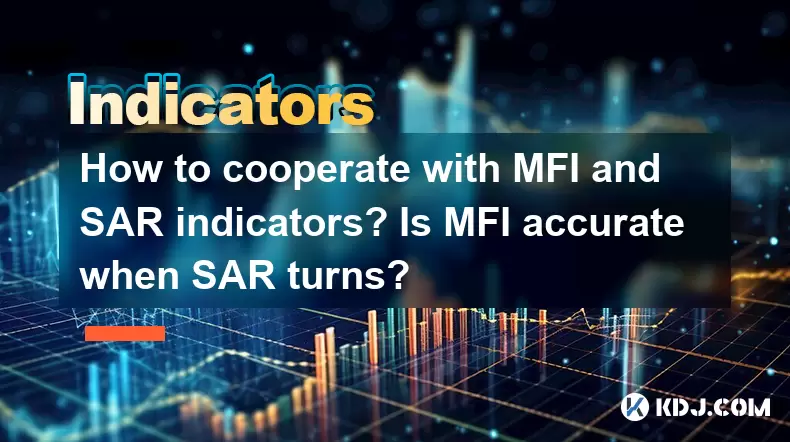
The Money Flow Index (MFI) and the Parabolic Stop and Reverse (SAR) are two popular technical indicators used by traders in the cryptocurrency market to make informed trading decisions. Understanding how these indicators work individually and in conjunction can help traders enhance their strategies. This article will delve into the mechanics of both indicators, how to cooperate with them effectively, and whether the MFI is accurate when the SAR turns.
Understanding the Money Flow Index (MFI)
The Money Flow Index (MFI) is an oscillator that uses both price and volume to measure buying and selling pressure. It ranges between 0 and 100 and is often used to identify overbought or oversold conditions in the market. The MFI is calculated using the following steps:
- Calculate the Typical Price (TP) for each period: TP = (High + Low + Close) / 3
- Calculate the Raw Money Flow (RMF): RMF = TP Volume
- Determine the Positive Money Flow (PMF) and Negative Money Flow (NMF) over a specified period (usually 14 days). PMF is the sum of RMF on days when the TP is higher than the previous day's TP, and NMF is the sum of RMF on days when the TP is lower.
- Calculate the Money Ratio (MR): MR = PMF / NMF
- Finally, calculate the MFI: MFI = 100 - (100 / (1 + MR))
The MFI is considered overbought when it exceeds 80 and oversold when it falls below 20. Traders often use these levels to predict potential reversals in the market.
Understanding the Parabolic Stop and Reverse (SAR)
The Parabolic Stop and Reverse (SAR), also known as the Parabolic SAR, is a trend-following indicator that provides potential entry and exit points. It is represented by dots placed above or below the price chart, depending on the direction of the trend. The SAR is calculated using the following steps:
- Start with an initial value for the SAR, usually the highest high or lowest low of the previous trend.
- Calculate the acceleration factor (AF), which starts at a small value (typically 0.02) and increases by a small increment (usually 0.02) each time a new extreme is reached, up to a maximum (typically 0.20).
- Calculate the new SAR value: New SAR = Previous SAR + Previous AF (Previous EP - Previous SAR), where EP (Extreme Point) is the highest high or lowest low since the last reversal.
The SAR dots flip positions when the price crosses them, indicating a potential trend reversal. When the dots are below the price, it suggests an uptrend, and when they are above the price, it suggests a downtrend.
Cooperating with MFI and SAR Indicators
To effectively cooperate with the MFI and SAR indicators, traders can combine their signals to enhance their trading strategies. Here’s how:
Identifying Trend and Momentum: Use the SAR to identify the overall trend direction. When the SAR dots are below the price, it indicates an uptrend, and when they are above the price, it indicates a downtrend. The MFI can then be used to gauge the strength of the trend. If the MFI is above 50 in an uptrend or below 50 in a downtrend, it confirms the strength of the trend.
Spotting Reversals: The SAR can signal potential trend reversals when the dots flip positions. Traders can use the MFI to confirm these reversals. For example, if the SAR dots flip from below to above the price, indicating a potential downtrend, and the MFI is above 80 (overbought), it suggests a strong possibility of a reversal.
Entry and Exit Points: Use the SAR dots as potential entry and exit points. When the SAR dots flip to indicate a new trend, traders can enter a position. The MFI can help fine-tune these entries. For instance, entering a long position when the SAR dots flip below the price and the MFI is below 20 (oversold) can provide a higher probability of success.
Divergence Signals: Look for divergences between the MFI and the price. If the price is making new highs but the MFI is not, it could indicate weakening momentum and a potential reversal. Combining this with the SAR can provide a stronger signal. For example, if the price is making new highs, the MFI is diverging, and the SAR dots are about to flip above the price, it suggests a high-probability short entry.
Is MFI Accurate When SAR Turns?
The accuracy of the MFI when the SAR turns depends on various factors, including market conditions and the specific cryptocurrency being traded. Here are some considerations:
Market Volatility: In highly volatile markets, the MFI may generate false signals more frequently. The SAR, being a trend-following indicator, can be more reliable in such conditions. When the SAR turns, traders should look for confirmation from the MFI, such as an overbought or oversold reading, to increase the accuracy of the signal.
Trend Strength: The strength of the trend can affect the accuracy of both indicators. In strong trends, the SAR is more likely to provide accurate signals, and the MFI can confirm these signals. If the MFI is in the overbought or oversold zone when the SAR turns, it increases the likelihood of a successful trade.
Time Frame: The time frame used can impact the accuracy of the indicators. On longer time frames, the SAR and MFI may provide more reliable signals. When the SAR turns on a longer time frame and the MFI confirms the turn with an overbought or oversold reading, the signal is more likely to be accurate.
Combining with Other Indicators: To increase the accuracy of the MFI when the SAR turns, traders can use additional indicators such as moving averages or the Relative Strength Index (RSI). If multiple indicators confirm the signal from the SAR and MFI, the accuracy of the trade is likely to be higher.
Practical Example of MFI and SAR Cooperation
Let's walk through a practical example of how to cooperate with the MFI and SAR indicators using a hypothetical cryptocurrency chart:
Step 1: Identify the Trend with SAR: Look at the chart and observe the position of the SAR dots. If the dots are below the price, it indicates an uptrend. If they are above the price, it indicates a downtrend.
Step 2: Check MFI for Confirmation: Once the trend is identified, check the MFI. If the MFI is above 50 in an uptrend or below 50 in a downtrend, it confirms the strength of the trend.
Step 3: Look for SAR Turn: Monitor the chart for a potential turn in the SAR. When the dots flip positions, it signals a potential trend reversal.
Step 4: Confirm with MFI: When the SAR turns, check the MFI. If the MFI is in the overbought zone (above 80) when the SAR turns from below to above the price, or in the oversold zone (below 20) when the SAR turns from above to below the price, it confirms the reversal signal.
Step 5: Execute Trade: Based on the confirmed signals, execute the trade. For example, if the SAR turns from below to above the price and the MFI is above 80, consider entering a short position.
Frequently Asked Questions
Q1: Can the MFI and SAR indicators be used effectively on all cryptocurrencies?The effectiveness of the MFI and SAR indicators can vary depending on the specific cryptocurrency being traded. Highly volatile cryptocurrencies may generate more false signals, so it's important to adjust the settings and time frames accordingly. For more stable cryptocurrencies, these indicators can be more reliable.
Q2: How often should I check the MFI and SAR indicators for optimal trading?The frequency of checking the MFI and SAR indicators depends on your trading strategy and time frame. For short-term traders, checking these indicators multiple times a day may be necessary. For long-term traders, daily or weekly checks might be sufficient. Always ensure you are monitoring the indicators in line with your trading plan.
Q3: Are there any other indicators that can enhance the cooperation between MFI and SAR?Yes, other indicators can enhance the cooperation between MFI and SAR. For example, moving averages can help confirm trends, while the Relative Strength Index (RSI) can provide additional insights into overbought and oversold conditions. Using multiple indicators can increase the accuracy of your trading signals.
Q4: What are the common pitfalls to avoid when using MFI and SAR together?Common pitfalls include relying solely on these indicators without considering market context, overtrading based on every signal, and not adjusting the settings of the indicators to suit the specific cryptocurrency and time frame. Always use these indicators as part of a broader trading strategy and consider other market factors before making trading decisions.
Disclaimer:info@kdj.com
The information provided is not trading advice. kdj.com does not assume any responsibility for any investments made based on the information provided in this article. Cryptocurrencies are highly volatile and it is highly recommended that you invest with caution after thorough research!
If you believe that the content used on this website infringes your copyright, please contact us immediately (info@kdj.com) and we will delete it promptly.
- Ripple (XRP) in 2026: Hold or Fold? A Look at XRP's Future and Emerging DeFi Alternatives
- 2025-11-08 18:35:01
- Zcash ZEC Coin Price Explosion: From Privacy Niche to Center Stage
- 2025-11-08 18:55:01
- Berachain Price Prediction: Navigating the Honeycomb Hype in Crypto
- 2025-11-08 18:55:01
- Arthur Hayes, Gold, and Bitcoin: A Modern Monetary Trinity?
- 2025-11-08 19:15:01
- Shiba Inu's Next Move: Navigating a Shifting Market
- 2025-11-08 19:20:01
- Pakistan's Crypto Crossroads: Balancing Opportunity with Asset-Backed Realities
- 2025-11-08 19:20:01
Related knowledge
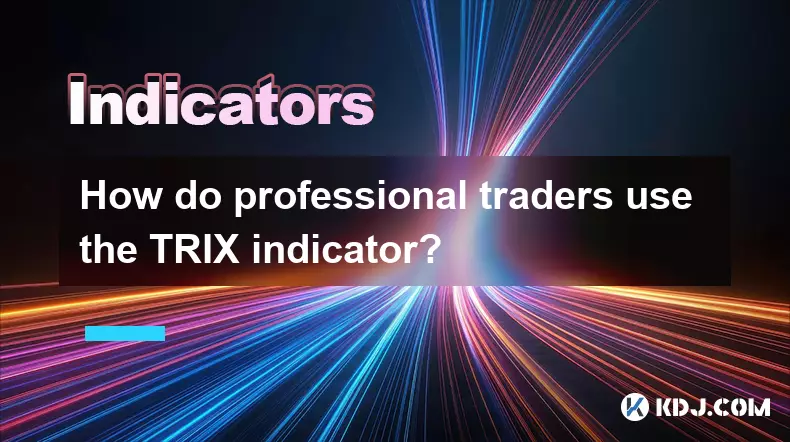
How do professional traders use the TRIX indicator?
Nov 06,2025 at 04:40pm
Understanding the TRIX Indicator in Crypto TradingThe TRIX (Triple Exponential Average) indicator is a momentum oscillator used by professional trader...
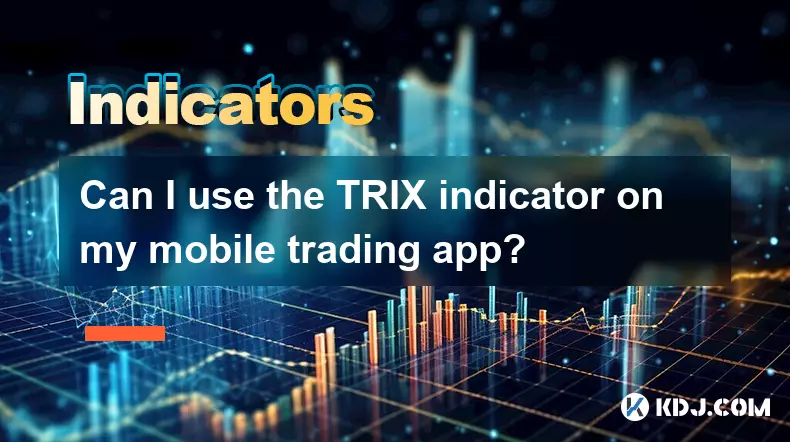
Can I use the TRIX indicator on my mobile trading app?
Nov 07,2025 at 07:40pm
The TRIX indicator, a momentum oscillator designed to filter out short-term fluctuations and highlight long-term trends, has become increasingly popul...
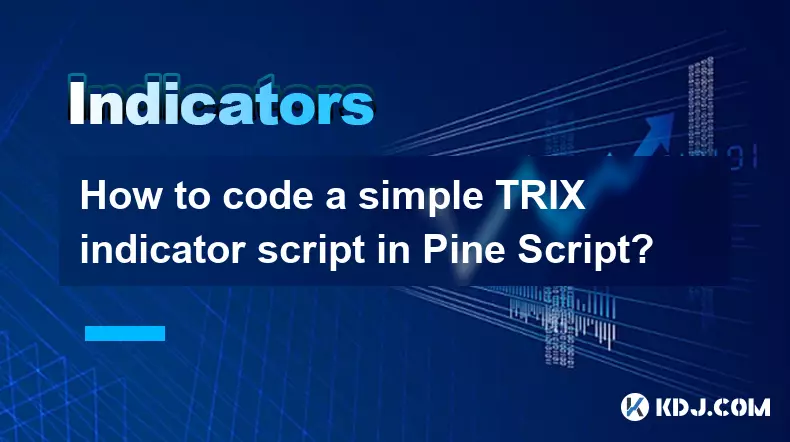
How to code a simple TRIX indicator script in Pine Script?
Nov 07,2025 at 06:20am
How to Code a Simple TRIX Indicator in Pine Script The TRIX (Triple Exponential Moving Average) indicator is widely used in cryptocurrency trading to ...
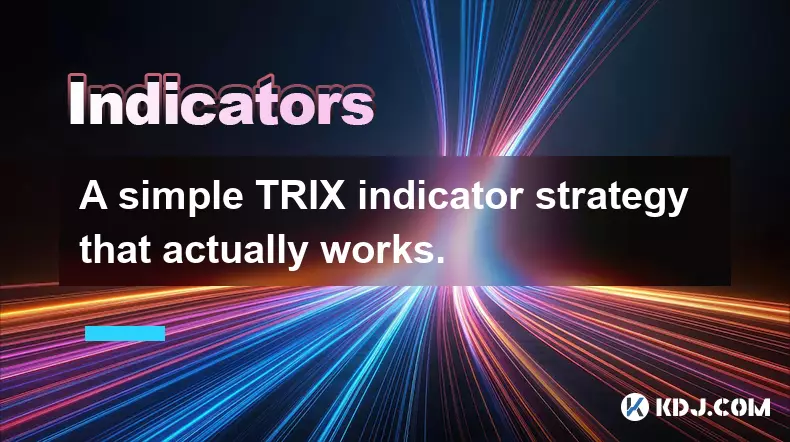
A simple TRIX indicator strategy that actually works.
Nov 08,2025 at 05:39pm
Understanding the TRIX Indicator in Crypto Trading1. The TRIX (Triple Exponential Average) indicator is a momentum oscillator designed to filter out s...
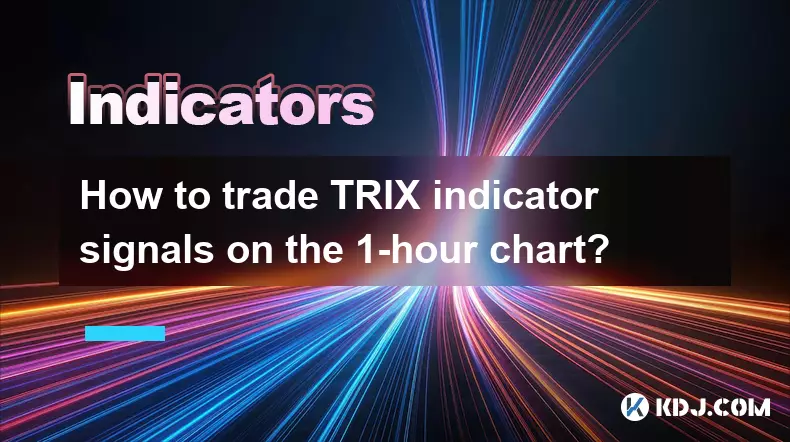
How to trade TRIX indicator signals on the 1-hour chart?
Nov 07,2025 at 05:39am
Bitcoin's Role in Decentralized Finance1. Bitcoin remains the cornerstone of decentralized finance, serving as a benchmark for value and security acro...
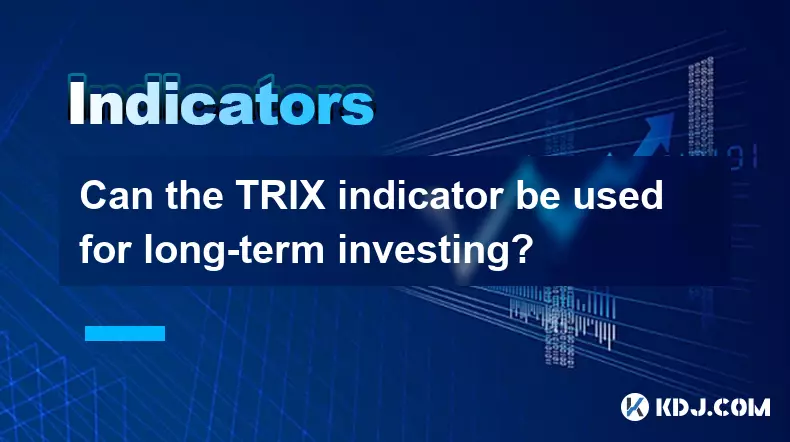
Can the TRIX indicator be used for long-term investing?
Nov 06,2025 at 02:19pm
Understanding the TRIX Indicator in Cryptocurrency Markets1. The TRIX (Triple Exponential Average) indicator is a momentum oscillator designed to filt...

How do professional traders use the TRIX indicator?
Nov 06,2025 at 04:40pm
Understanding the TRIX Indicator in Crypto TradingThe TRIX (Triple Exponential Average) indicator is a momentum oscillator used by professional trader...

Can I use the TRIX indicator on my mobile trading app?
Nov 07,2025 at 07:40pm
The TRIX indicator, a momentum oscillator designed to filter out short-term fluctuations and highlight long-term trends, has become increasingly popul...

How to code a simple TRIX indicator script in Pine Script?
Nov 07,2025 at 06:20am
How to Code a Simple TRIX Indicator in Pine Script The TRIX (Triple Exponential Moving Average) indicator is widely used in cryptocurrency trading to ...

A simple TRIX indicator strategy that actually works.
Nov 08,2025 at 05:39pm
Understanding the TRIX Indicator in Crypto Trading1. The TRIX (Triple Exponential Average) indicator is a momentum oscillator designed to filter out s...

How to trade TRIX indicator signals on the 1-hour chart?
Nov 07,2025 at 05:39am
Bitcoin's Role in Decentralized Finance1. Bitcoin remains the cornerstone of decentralized finance, serving as a benchmark for value and security acro...

Can the TRIX indicator be used for long-term investing?
Nov 06,2025 at 02:19pm
Understanding the TRIX Indicator in Cryptocurrency Markets1. The TRIX (Triple Exponential Average) indicator is a momentum oscillator designed to filt...
See all articles





















![The Graph Price Prediction [GRT Crypto Price News Today] The Graph Price Prediction [GRT Crypto Price News Today]](/uploads/2025/11/07/cryptocurrencies-news/videos/690d4df44fe69_image_500_375.webp)




















































